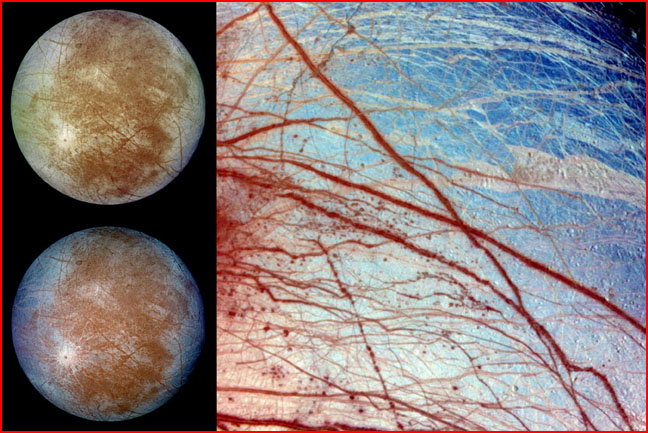
home •
about •
essential guide •
picture of the day •
thunderblogs •
news •
multimedia •
predictions •
products •
get involved •
contact

Credit: NASA/JPL/Galileo imaging team
pic of the day
archive
subject index
abstract
archive
Links:
Society for
Interdisciplinary
Studies
Mar 11, 2005
Electrical Rilles of Europa
Jupiter’s moon Europa, the second large satellite out from the gas giant, is about one half the size of our Moon. Mapped in detail by the Galileo probe, it reveals the most spectacular and concentrated accumulation of rilles in the solar system. Its surface is a maze of intersecting channels. Some of the channels are more than 1,600 kilometers (1,000 miles) long, and they often retain a remarkably constant width along their full length.
Punctuating this complex network are two massive chaotic regions. One is just west of the sub-Jovian point (the point closest to Jupiter); the other is on the opposite side of Europa. These chaotic regions are marked by episodes of melting, ice rafting, and re-freezing. Significantly, they are connected by giant rilles that follow great circles or that loop weirdly across the Europan surface.
The picture on the lower left and the picture on the right have been enhanced to emphasize discoloration by an unknown process. From the first close-ups of the Voyager 2 probe in 1979, planetary scientists have speculated that the dark linear marks on the surface were “cracks” or “fractures” in the ice. This interpretation prompted some to suggest that the sphere of Europa had expanded by some ten percent. Under the “fracturing” interpretation, the dark reddish coloring was produced by subsurface dirty liquid or “slush” spilling out to form levees on the two sides of the gorges.
The electrical interpretation sees something much different. In the violent evolutionary phases that carved its surface, Europa was the target of catastrophic electric discharges emanating from Jupiter. In this interpretation, there is a reason why the scarring pattern on Europa matches that of an arc pattern on a novelty “plasma ball”: Undulating plasma discharge filaments raced across Europa’s surface at lightning speed in a vast “line explosion,” excavating material to deposit it in levees on the sides of the resulting trenches.
See the Picture of the Day for October 19, 2004: Europa Caught in the Middle
The picture on the right emphasizes the intimate connection between rilles and concentrations of craters. As powerful arcs tore across the surface, secondary filaments sputtered about erratically. They touched down on adjoining regions, sticking momentarily to one point after another, leaving pockmarks of generally constant size. They produced the same discoloration as seen along the rilles. A continuous arc can cut a remarkably smooth channel, as if a router were being dragged across the surface. But periodic sputtering of discharge filaments is evident in the larger picture above, where we see a concentration of pits, and not just in the general regions where the channels are most dense; some of the pits are centered along the channels themselves. This enigmatic relationship of cratering patterns to rille formation thus becomes a key to the electrical interpretation, with implications reaching far beyond Europa.
What, then, of the unique coloring of the excavated material? Wallace Thornhill has suggested that the reddish coloring may be due to sulfur produced by a transmutation of elements: The electric field strength in an interplanetary thunderbolt could fuse two oxygen nuclei together into a sulfur nucleus. If the electrical transmutation principle is valid, this would be only one instance in a solar system filled with analogous events. Europa’s neighbor Io, the closest large moon to Jupiter, is drenched in sulfur, and here electrical transactions are obvious. It is probable that Io originally looked more like the other icy Galilean moons.
See Picture of the Day, Dec 13, 2004 Io and the ‘Greatest Surprise’
See also, Dec 17, 2004, Io's ‘Volcanoes’ Blur Scientific Vision
Concentrations of sulfur in Venus’s atmosphere and in the surface of Mars would thus warrant investigation from an entirely new vantage point. And Earth could hardly be excluded. In ancient times, witnesses reported the fall of sulfur in connection with “the thunderbolts of the gods”. The brimstone in the familiar phrase “fire and brimstone” means sulfur. Even to this day, widespread reports insist that a sulfurous stench follows in the wake of energetic lightning strikes. Rationalizations that the witnesses were “smelling ozone” have never been convincing to skeptics.
The inspiration for this electrical interpretation came originally from maverick theorist Immanuel Velikovsky. But now independent research may be moving in the very direction indicated here. In 2002, Russian researchers L.I. Urutskoev, V.I. Liksonov, and V.G. Tsinoev, with the Kurchatov Institute, announced that their experiments with electric explosion in water produced “new chemical elements”. Nothing preexisting in the experimental set-up could account for the presence of the elements detected after the electric discharge in water.
The new scientific vistas of the “Electric Universe” have already reached into disciplines well beyond astronomy and planetary geology.
Additional archive links relating to discharge
on Io—
Dec 22, 2004 “Retrospective on Io”
Dec 16, 2004 “Io's ‘Volcano’ Prometheus”
Dec 15, 2004 “Predicting the Electrical Etching of Io”
EXECUTIVE EDITORS:
David Talbott, Wallace Thornhill
MANAGING EDITOR: Amy Acheson
CONTRIBUTING EDITORS: Mel Acheson, Michael Armstrong, Dwardu Cardona,
Ev Cochrane, C.J. Ransom, Don Scott, Rens van der Sluijs, Ian Tresman
WEBMASTER: Michael Armstrong
Copyright 2005: thunderbolts.info